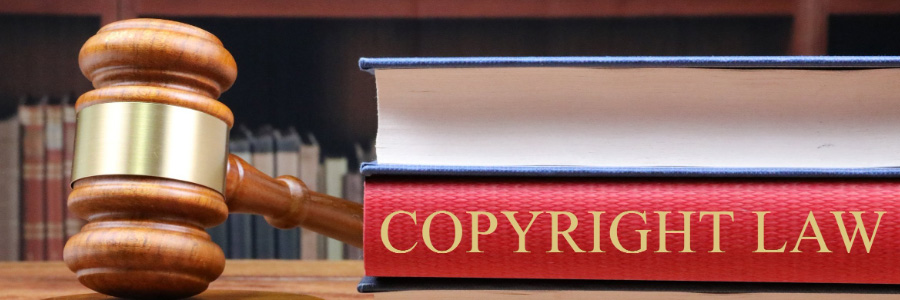Copyright Law in Canada: A newcomer’s guide
 Copyright Law by Nick Youngson from Pix4free.org. CC BY-SA
Copyright Law by Nick Youngson from Pix4free.org. CC BY-SA
Picture someone coming up with an idea. They work on it day and night, researching, designing, and testing their idea. Finally, they bring it to life by writing a book or story, or creating a sculpture, painting, or song. They marvel at their creation and decide that it’s too beautiful not to share. They post it on their personal account on social media.
Now imagine someone copying this creation and then claiming it as their own. They make exact copies of it and sell it to others. They even create a website dedicated to this creation.
How would you feel if you’re original creator? Conversely, do you see anything wrong about the other person copying the creation and claiming it as their own?
What is copyright?
Copyright is a legal concept that gives creators exclusive rights to their original works. These works can include literary pieces, music, art, and even computer programs. In Canada, copyright protection is automatic. You get it upon the creation of the work, and there is no need to register it.
The copyright holder has the right to reproduce, distribute, perform, and display their work. This protection is in place to encourage creativity and ensure that creators can benefit from their efforts.
What is copyright? (Canada), Government of Canada
Please note: Copyright Law has been updated. Work is declared Public Domain after the creator’s death plus 70 years (not 50 years).
We all need to understand copyright, especially in these times when creations are readily available and accessible online. Both creators and consumers can benefit from knowing its parameters. For creators, it means safeguarding their hard work and ensuring they receive credit and compensation for their creations. For consumers, being aware of copyright helps them use materials within their limits and avoid legal issues related to using copyrighted material without permission.
In Canada, copyright law not only upholds the rights of Canadian creators but also those from other countries, thanks to international agreements. Being aware of copyright rules ensures that newcomers (in fact, all of us) can engage with the local creative scene or use various materials while respecting the rights of others.
Are there instances when you can use copyrighted materials without permission?
Yes, this is called fair dealing. Fair dealing is part of copyright law that allows the use of copyrighted material for specific purposes without permission from, or payment to, the copyright holder. These purposes include research, private study, criticism, review, news reporting, education, satire, and parody. For example, a teacher can use a short excerpt of a copyrighted work for a class handout without asking permission from the author.
It’s important to note that the use must be fair, and the user must give proper credit to the copyright holder. You can check the booklet Copyright Matters! (4th Edition) to learn more about fair dealing for educators. When in doubt, it’s advisable to seek legal advice or use alternative, non-copyrighted material.
How do you get a copyright?
As mentioned, copyright protection is automatic upon the creation of a work. However, there are steps you can take to strengthen your position as a copyright holder. Adding the copyright symbol (©), your name, and the year of creation to your work shows others that you are aware of your rights.
You can also register your work with the Canadian Intellectual Property Office (CIPO) for extra protection. You don’t have to do it, but registration can serve as evidence in case of legal disputes. It will allow you to claim statutory damages and legal fees.
Getting your work registered is easy. You can even do it online. However, you would have to pay a fee.
Tips to avoid copyright infringement:
Respecting copyright is not only about protecting your own work but also avoiding legal trouble when using others’ creations. Here are a few tips to help you navigate copyright matters:
- Use materials under public domain – Public domain works are not protected by copyright and can be freely used by anyone. To ensure that the material you’re using is in the public domain, check your source. Media sharing sites usually indicate whether materials are free to use, copyrighted, or under a Creative Commons license.
- Use Creative Commons licenses – Some creators allow certain uses of their work through Creative Commons licenses. Check the license terms and follow their conditions when using the material. Read What is Creative Commons and why do you need to know about it? to learn more about CC-licenses.
- Get permission – It is always best to seek permission if you want to use someone else’s work. This can involve contacting the creator directly or using platforms that offer licensed content.
- Give proper attribution – When using someone else’s work under fair dealing or a license, always provide proper attribution. Follow the terms given by the author when giving credit especially when specified.
Understanding copyright law is an important part of respecting the creative contributions of individuals around you. By being aware of how copyright works, obtaining permission when necessary, and following fair dealing guidelines, you contribute to a thriving and respectful creative community in your new home.
Sources: A guide to copyright, Government of Canada; Copyright Matters! Some key questions & answers for teachers 4th Edition , Wanda Noel and Jordan Snel, Council of Ministers of Education, Canada Canadian School Boards Association Canadian Teachers’ Federation. Accessed January 11, 2024.
